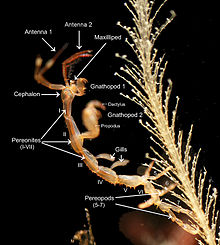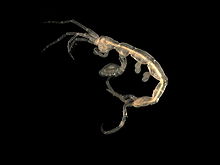|
Caprellidae
Caprellidae is a family of amphipods commonly known as skeleton shrimps. Their common name denotes the threadlike slender body which allows them to virtually disappear among the fine filaments of seaweed, hydroids and bryozoans. They are sometimes also known as ghost shrimps.[2] Description Caprellids are easily recognizable from other amphipods because of their slender elongated bodies. Their bodies can be divided into three parts: the cephalon (head), the pereon (thorax), and the abdomen. The pereon comprises most of the length of the body. It is divided into seven segments known as pereonites. The cephalon is usually fused to the first pereonite; while the highly reduced and almost invisible abdomen is attached to the posterior of the seventh pereonite. They possess two pairs of antennae, with the first pair usually longer than the second pair. The cephalon contains mandibles, maxillae, and maxillipeds which function as mouthparts.[3][4] Each pereonite has a pair of appendages known as pereopods. The first two pairs are modified into raptorial appendages known as gnathopods. These are used for feeding and defense, as well as locomotion. The third and fourth pair of pereopods are usually reduced or absent altogether. In the third and fourth pereonites are two pairs of gills. Sometimes a third pair of gills may also be present on the second pereonite. In mature females, brood pouches formed by extensions of the coxae (oostegites) are present on the third and fourth pereonites. The fifth to seventh pair of pereopods are smaller than the gnathopods and are used for clasping objects the animals anchor themselves upon.[3][4] Most caprellids are highly sexually dimorphic, with the males usually being far larger than the females.[5] Ecology Caprellids are exclusively marine and are found in oceans worldwide. A few species are found in the ocean depths, but most prefer low intertidal zones and subtidal waters among eelgrass, hydroids and bryozoans. They are typically seen attached to substrate by their grasping appendages called the pereopods. Caprellids are omnivorous, feeding on diatoms, detritus, protozoans, smaller amphipods, and crustacean larvae. Some species are filter feeders, using their antennae to filter food from the water or scrape it off the substrate. Most species are predators that sit and wait like a praying mantis, with their gnathopods ready to snatch any smaller invertebrates which come along. They accentuate their adaptive form and colouration by assuming an angular pose, resembling that of the fronds among which they live.[6] They remain motionless for long periods of time while waiting to ambush their prey, often protozoa or small worms. Caprellids are typically preyed upon by surf perch, shrimp, nudibranchs such as the lion nudibranch Melibe leonina and brooding anemones (Epiactis prolifera). Since they often inhabit eelgrass beds with sessile jellyfish, (Haliclystus and Thaumatoscyphus), the caprellids frequently become jellyfish food.[7] Caprellids are not normally considered a main source of food for fish, but when shiner perch (Cymatogaster aggregata) migrate into the eelgrass beds for reproduction, they target caprellids.[8] Reproduction and growthMating can only occur when the female is between the new and hardened exoskeletons, which both male and female molt in order to grow. After mating the female will brood the fertilized eggs within her brood pouch. The young will hatch and emerge as juvenile adults.[9] After mating, the female in some species have been known to kill the males by injecting venom from a claw within their gnathopod.[10] TaxonomyCaprellidae is classified under the superfamily Caprelloidea which belongs to the infraorder Caprellida of the suborder Corophiidea. Caprellidae contains 1345 genera in three subfamilies.[1] Caprellinae
Paracercopinae
Phtisicinae
References
External links
|
||||||||||||||||||||||||||||||||
Portal di Ensiklopedia Dunia
